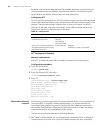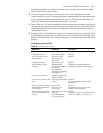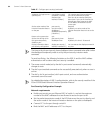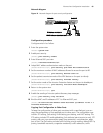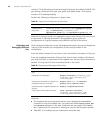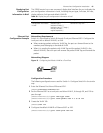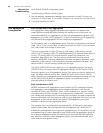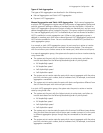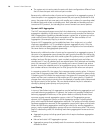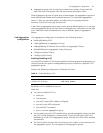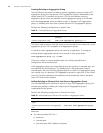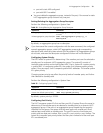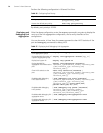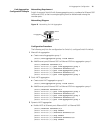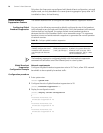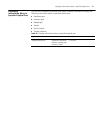70 CHAPTER 3: PORT OPERATION
■ The system sets to inactive state the ports with basic configurations different from
that of the active port with minimum port number.
Because only a defined number of ports can be supported in an aggregation group, if
the active ports in an aggregation group exceed the port quantity threshold for that
group, the system shall set some ports with smaller port numbers (in ascending order)
as selected ports and others as standby ports. Both selected and standby ports can
transceive LACP protocol, but standby ports cannot forward user service packets.
Dynamic LACP Aggregation
The LACP uses peer exchanges across the links to determine, on an ongoing basis, the
aggregation capability of the various links, and continuously provides the maximum
level of aggregation capability achievable between a given pair of systems as well as
under manual control through direct manipulation of the state variables of Link
Aggregation (for example, keys) by a network manager.
Dynamic LACP aggregation can be established even for a single port, as is called
single port aggregation. LACP is enabled at dynamic aggregation ports. Only the
ports with the same speed, duplex mode and basic configuration and connected to
the same device can be aggregated dynamically.
Because only a defined number of ports can be supported in an aggregation group, if
the ports in an aggregation group exceed the port quantity threshold for that group,
the system shall set some ports with smaller system IDs (system priority + system MAC
address) and port IDs (port priority + port number) as selected ports and others as
standby ports. If not, all member ports are selected ports. Both selected and standby
ports can transceive LACP protocol, but standby ports cannot forward user service
packets. Among the selected ports of an aggregation group, the one with minimum
port number serves as the master port for that group and the others are sub-ports.
In comparing system IDs, the system first compares system priority values; if they are
equal, then it compares system MAC addresses. The smaller system ID is given priority.
Comparing port IDs follows the same process: the system first compares port priority
values and then port numbers and the smaller port ID is given priority. If system ID
changes from non-priority to priority, then the selected or standby state is determined
by the port priority of the system. You can decide whether the port is selected or
standby by setting system priority and port priority.
Load Sharing
In terms of load balancing, link aggregation may be load balancing aggregation and
non-load balancing aggregation. In general, the system only provides limited load
balancing aggregation resources, so the system needs to rationally allocate these
resources among manual aggregation groups, static LACP aggregation groups,
dynamic LACP aggregation groups, and the aggregation groups including special
ports which require hardware aggregation resources. The system will always allocate
hardware aggregation resources to the aggregation groups with higher priority levels.
When the load sharing aggregation resources are used up for existing aggregation
groups, newly-created aggregation groups will be non-load sharing ones. The priority
levels (in descending order) for allocating load sharing aggregation resources are as
follows:
■ Aggregation groups including special ports which require hardware aggregation
resources
■ Manual and static LACP aggregation groups
■ Aggregation groups that probably reach the maximum rate after the resources are
allocated to them



